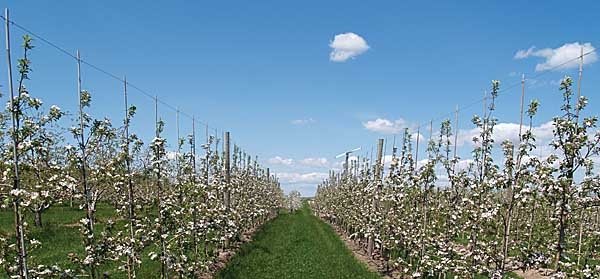
by Phil Schwallier, Michigan State University
Welcome home to where it all began!
The 53rd annual International Fruit Tree Association meeting and pre- and postconference workshop and tours will be held February 27 to March 3, with the Amway Grand Plaza Hotel in Grand Rapids, Michigan as home base. This year’s conference promises to be one of the best.
We are pleased to include the Art Mitchell Symposiums on High Density Apple and Sweet Cherry and Plant Growth Regulators as part of the conference’s technical program. The half-day symposiums, scheduled for March 1 and March 3, are sponsored by the Mitchell family to honor Art’s memory and work in horticulture at Michigan State University.
Preconference events include a high-density orchard workshop on February 27 and a tour of sweet cherries grown under high tunnels on February 28. As part of the main conference, which runs March 1–3, attendees will tour Michigan’s Ridge production area on March 2 to see vertical axe, tall spindle, and other trellis systems for apples and the best of Gisela plantings for sweet cherry. Other tour stops include Phil Brown Welding to see new orchard equipment, a packing house, and a farm market. A postconference tour from March 4–6 focuses on the cherry capital of the world, Traverse City, with visits to progressive processors and orchards.
The beautiful bays of Grand Traverse provide a gorgeous setting for other interests, such as vineyards, wineries, farm markets, lighthouses, Sleeping Bear Sand Dunes National Park, and other historical sites. The area also has the finest fruit-growing sites of Michigan, with an exceptional climate for producing tart cherries and other tree fruit.
Conference highlights
IFTA was founded in Michigan in 1957 and has since become internationally known for its outstanding annual conferences, drawing experts from around the world. As part of the symposium on plant growth regulators, Dr. Stefano Musacchi of the University of Bologna, Italy, will discuss the use of plant growth regulators in pear, apple, and cherry in Europe and share data on high density systems for apple and sweet cherry. Dr. John Palmer of New Zealand’s HortResearch will discuss using plant growth regulators to promote feathering of apple and pear trees and gibberellic acid sprays to reduce return flowering and improve fruit size.
North American speakers include: Michigan State University’s Dr. Greg Lang, Dr. Jim Flore, Dr. Randy Beaudry, and Dr. Ron Perry; Cornell University’s Alison DeMarree, Dr. Chris Watkins, Dr. Gennaro Fazio, Steve Hoying, Dr. Terence Robinson, and Dr. Lailiang Cheng; Pennsylvania State University’s Dr. Jim Schupp; University of Massachusetts’s Dr. Duane Greene; North Carolina State University’s Dr. Steve McArtney and Dr. Sylvia Blankenship; Washington State University’s Dr. Don Elfving; Dr. Denise Neilson, British Columbia, Canada; and Dr. Jennifer DeEll and Dr. John Cline from Ontario, Canada.
Topics presented during the technical conference include:
• High density systems for apple and sweet cherry
• Sweet cherry production in high tunnels
• Economics of systems, thinning, and new technologies
• New technologies for machine-assisted fruit production
• Rootstocks, Honeycrisp, fertigation, and more
The plant growth regulator symposium will look at growth regulators used to impact fruit set as well as those that relate to harvest and postharvest. Topics include:
• Flowering, fruiting, pollination, and fruit set
• Chemical thinning, blossom thinning, thinning materials
• Factors affecting fruit set, shade, temperatures, and sunny conditions
• Carbohydrate model for predicting fruit set and thinning sensitivity
• Use of plant growth regulators — Apogee, NAA, Ethrel, Provide, Promalin
• Variety sensitivity to plant growth regulators
• Apple maturation, ethylene and fruit drop
• ReTain and NAA use and effects
• Development of the MCP molecule
• SmartFresh use and postharvest handling technologies
• Variety sensitivity to harvest plant growth regulators
Come discover Michigan, renew industry acquaintances, and stay abreast of the latest orchard developments!

Leave A Comment